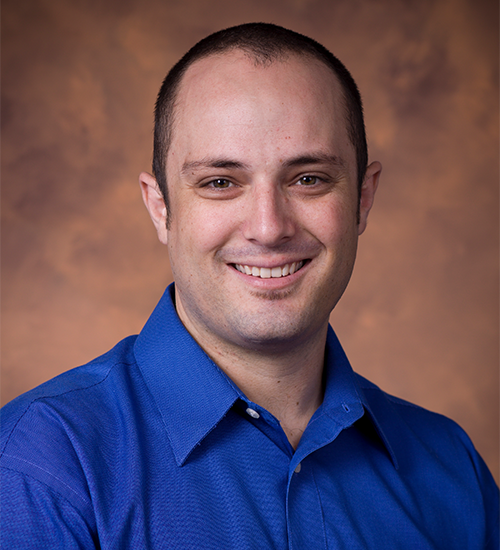Dr. Eric McLamore
Associate Professor, Biosensors
Eric McLamore is an associate professor with a focus on biosensors. McLamore describes a biosensor as a device that uses some part of an organism to generate a useful measuring or monitoring signal. He cites a classic example, the canary in the coal mine, which miners carried with them to detect toxic gases. Of course, most modern biosensors do not engage an entire animal. Modern biosensor specialists are more likely to use a single component of an organism -- biochemicals for instance -- and exploit their specific properties. And in contrast to the canary, which can only give qualitative messages about whether a toxic gas is present, the kind of biosensors that McLamore and his colleagues strive to create give quantitative signals that can tell exactly how much of a substance is present.
Most biosensors are on the cutting edge of technology, and yet the idea has been around for over a century. The result is that a lot of research has been done and a lot of tools are available. McLamore says that, in many cases, an off-the-shelf approach is not possible because solving complex problems means finding the right combination of tools for a specific application. Developing new biosensor technologies is only one part of McLamore's work. McLamore's goal is not just to be the engineer who makes the right biosensor, he wants to tackle problems in his scientific domains of interest -- agriculture, the environment, and medicine -- and solve those problems.
In the agricultural area, McLamore is interested in developing biosensors that monitor physiological transport in plants. He says that biosensor technology can be used to understand the physiology of any plant, but it is especially interesting in the study of genetically modified (GMO) plants and diseases such as pathogen infection. McLamore's non-invasive biosensors do not interfere with the plant's physiology and are simply "silent observers."
In the environmental area, McLamore discusses the use of biofilms, which are films created by bacteria and other one-celled organisms on various surfaces. A common example of a biofilm is the plaque that people are constantly reminded to remove from their teeth. McLamore uses biosensors to understand the cells in a biofilm, both for improving engineered biofilm systems and for turning the biofilm itself into a monitoring device with sensitivity to environmental toxins or disease agents.
In a biomedical application, McLamore describes a dramatic application of biosensors in epilepsy. Over two million Americans suffer from epilepsy. Despite medication, some are at risk for a sudden attack of convulsions that leaves them temporarily helpless and can require hours or days of recovery. McLamore has worked on a biosensor that employs an enzyme and carbon nanotubes which can detect changes in neuron activity. Because the device works in real time, it could potentially give a patient a warning of oncoming seizure and provide an opportunity to find a safe position or take measures to prevent the seizure.

Contact Information
352-294-6703
Office:
105 Frazier Rogers Hall
Mailing Address:
P.O. Box 110570
Gainesville, FL 32611-0570
-
Teaching
- ABE 4043C: Senior Design II
- ABE 4033/5038: Fundamentals and Applications of Biosensors
- ABE 4935/5936: Writing Grant Proposals
-
Research
Departmental Research Area:
- Biological Engineering
Research Focus:
- Sensor and biosensor fabrication
- Biomacromolecule-nanoparticle interactions
- Cell/tissue physiology
- Field sampling and in situ analysis
-
Education
- Ph.D. Civil/Ag & Bio Engineering, Purdue University, 2008
- M.S. Civil/Environmental Engineering, Texas Tech University, 2004
- B.S. Civil Engineering, Texas Tech University, 2002
-
Professional Experience
- 2016 - Present
Associate Professor, Department of Agricultural and Biological Engineering, University of Florida - 2010 - 2016
Assistant Professor, Department of Agricultural and Biological Engineering, University of Florida - 2009 - 2010
Research Scientist, Department of Agricultural and Biological Engineering, Birck Nanotechnology Center, Bindley Bioscience Center, Purdue University - 2008 - 2009
Post Doctoral Research Associate, School of Civil Engineering, Purdue University
- 2016 - Present
- Publications
-
Awards and Honors
- USDA New Teacher Award for Excellence in Teaching in the Food and Agricultural Sciences, 2016
- Best Paper Award, SPIE, 2016
- Best Student Paper Award, SPIE, 2016
- HOT Article Award, Analyst, 2015
- Researcher of the Year, Florida Section - American Society of Agricultural and Biological Engineers, 2015
- A.W. Farrall Young Educator Award, 2015
- Florida Section Teacher of the Year, American Society of Agricultural and Biological Engineers, 2014
- Early Career Award, UF/IFAS, 2013
- Excellence Award to Assistant Professors, University of Florida, 2012
- Innovation Award, University of Florida, 2011
-
Community Outreach
- Co-Director, 4-H Biosensors Summer Camp
A hands-on workshop for underprivileged pre-collegiate students, high school teachers, and extension agents. - Director, Plant Club
An extension/outreach program targeting pre-kindergarten, youth, and teachers.
- Co-Director, 4-H Biosensors Summer Camp
-
Other Professional Activities
- Faculty Advisor, Society for Advancement of Chicanos/Hispanics and Native Americans in Science (SACNAS)
- Councilor at Large, Institute of Biological Engineering (IBE)
- Associate Editor, Chemical Sensors, Simplex Academic Publishers (ISSN 2231 – 6035)
- Associate Editor, Advances in Nanoparticles, Scientific Publishing Inc. (ISSN 2169-0510)
